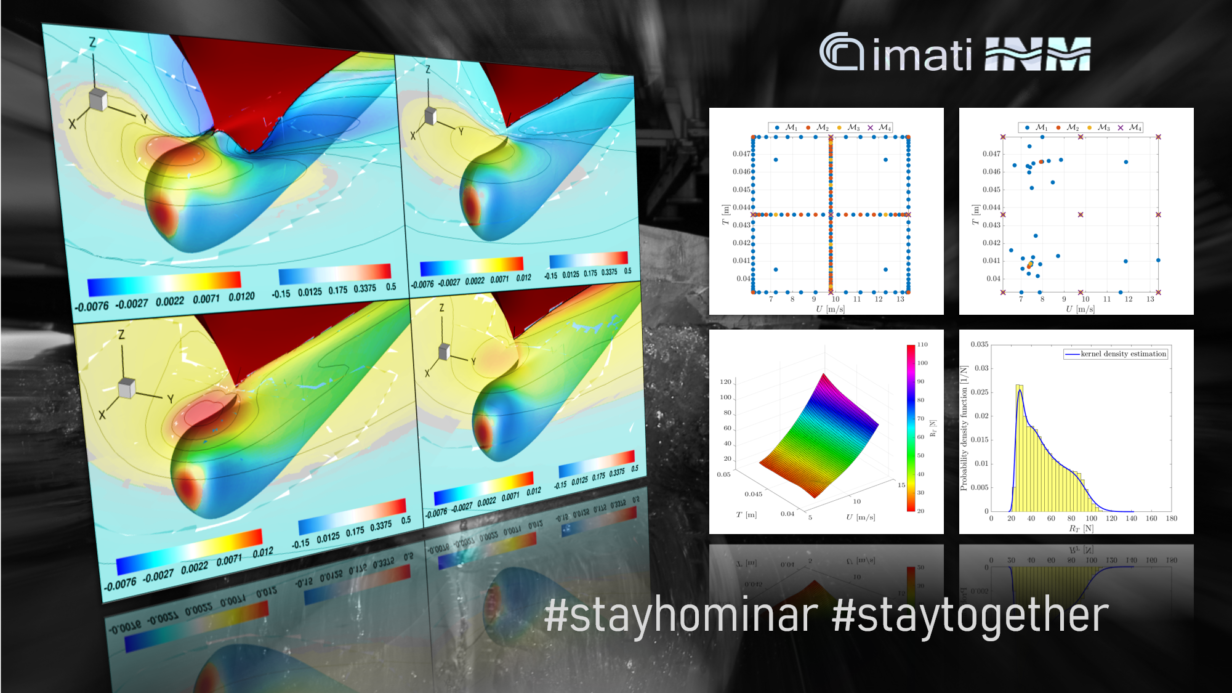
Highlights from: Piazzola C., Tamellini L., Pellegrini R., Broglia R., Serani A., and Diez M., “Uncertainty Quantification of Ship Resistance via Multi-Index Stochastic Collocation and Radial Basis Function Surrogates: A Comparison,” 21th AIAA/ISSMO Multidisciplinary Analysis and Optimization Conference (MA&O), AVIATION 2020, June 15-19, 2020
Where and when
Google Meet, Friday 10 July 2020, 12:00
Abstract
The seminar presents a recent study by the IMATI/INM working group on uncertainty quantification (UQ). A comparison of two methods for the forward UQ of complex industrial problems is presented. Specifically, the performance of Multi-Index Stochastic Collocation (MISC) and adaptive multi-fidelity Stochastic Radial Basis Functions (SRBF) surrogates is assessed for the UQ of a roll-on/roll-off passengers ferry advancing in calm water and subject to two operational uncertainties, namely the ship speed and draught. The estimation of expected value, standard deviation, and probability density function of the (model scale) resistance is presented and discussed, obtained by multi-grid Reynolds averaged Navier-Stokes (RANS) computations. Both MISC and SRBF use as multi-fidelity levels the evaluations on different grid levels, intrinsically employed by the RANS solver for multi-grid acceleration; four grid levels are used here, obtained as isotropic coarsening of the initial finest mesh. The results suggest that MISC could be preferred when only limited data sets are available. For larger data sets both MISC and SRBF represent a valid option, with a slight preference for SRBF, due to its robustness to noise.
Short bio
Lorenzo Tamellini got a M.Sc. in Mathematical Engineering and a Ph.D. in Mathematical Methods and Models for Engineering at Politecnico di Milano. After a post-doc at École polytechnique Fédérale de Lausanne, he became a researcher at CNR-IMATI in February 2016. His scientific interests are numerical methods for uncertainty quantification and isogeometric analysis.
Chiara Piazzola got a M.Sc. in Mathematics at the University of Verona, and a PhD in Mathematics at University of Innsbruck on low-rank approximation of high-dimensional problems. She’s been a post-doc at CNR-IMATI since March 2020, where she works on numerical methods for uncertainty quantification.
Riccardo Pellegrini is a Postdoctoral Research Fellow at CNR-INM, working on multidisciplinary analysis and optimization. He achieved his master’s degree in Aeronautical Engineering at the University Roma Tre in 2014. He achieved his Ph.D. in Mechanical and Industrial Engineering from the same university in 2017.
Andrea Serani is a Research Scientist at CNR-INM. He received his Ph.D. in Mechanical and Industrial Engineering from the University Roma Tre in 2016. In 2013, he joined CNR-INM (formerly INSEAN) as a Ph.D. Fellow and became Research Scientist in 2019, joining the research group in multidisciplinary analysis and optimization.
Riccardo Broglia is Research Scientist at CNR-INM (formerly INSEAN) since 1997, when he joined the CFD development and application group. He earned his PhD in Theoretical and Applied Mechanics from the Sapienza University of Rome in 1993. He was visiting stager/researcher at Von Karman Institute in 1994-1995, visiting researcher at University of Maryland, Department of Mechanical and Aerospace Engineering 2002.
Matteo Diez is a Senior Research Scientist at CNR-INM, where he leads a research group in multidisciplinary analysis and optimization. He achieved his Ph.D. in Mechanical and Industrial Engineering from the University Roma Tre in 2007. He joined CNR-INM (formerly INSEAN) in 2008. He was visiting research scholar at the University of Iowa from 2011 to 2017.
Info
For information on joining the webinar, please send an email to and
Conference presentation
The conference version of the presentation can be watched below.

